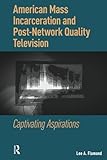American Mass Incarceration and Post-Network Quality Television : Captivating Aspirations / Lee Flamand.
Material type: TextPublisher: Amsterdam : Amsterdam University Press, [2022]Copyright date: ©2022Description: 1 online resource (312 p.)Content type:
TextPublisher: Amsterdam : Amsterdam University Press, [2022]Copyright date: ©2022Description: 1 online resource (312 p.)Content type: - 9789463725057
- 9789048553686
- Criminal justice, Administration of -- United States
- Mass media and criminal justice -- United States
- Prisons in mass media
- Prisons -- United States
- Cultural Studies
- Film, Media, and Communication
- Interdisciplinary Studies
- Media Studies
- Radio and Television
- PERFORMING ARTS / Television / General
- Post-Network Television, Mass Incarceration, Race, Prison, New Golden Age of TV
- 791.4575 23
- PN1992.8.P75
- online - DeGruyter
| Item type | Current library | Call number | URL | Status | Notes | Barcode | |
|---|---|---|---|---|---|---|---|
 eBook
eBook
|
Biblioteca "Angelicum" Pont. Univ. S.Tommaso d'Aquino Nuvola online | online - DeGruyter (Browse shelf(Opens below)) | Online access | Not for loan (Accesso limitato) | Accesso per gli utenti autorizzati / Access for authorized users | (dgr)9789048553686 |
Frontmatter -- Table of Contents -- The Captivating Aspirations of Post-Network Quality Television in the Age of Mass Incarceration: An Introduction -- 1. Mass (Mediating) Incarceration -- 2. How Does Violent Spectacle Appear as TV Realism? Sources of OZ’s Penal Imaginary -- 3. If It’s Not TV, is It Sociology? The Wire -- 4. Is Entertainment the New Activism? Orange Is the New Black, Women’s Imprisonment, and the Taste for Prisons -- 5. Can Melodrama Redeem American History? Ava DuVernay’s 13th and Queen Sugar -- Conclusion: American Politics and Prison Reform after TV’s Digital Turn -- Bibliography -- Acknowledgements -- Index
restricted access online access with authorization star
http://purl.org/coar/access_right/c_16ec
Far more than a building of brick and mortar, the prison relies upon gruesome stories circulated as commercial media to legitimize its institutional reproduction. Perhaps no medium has done more in recent years to both produce and intervene in such stories than television. This unapologetically interdisciplinary work presents a series of investigations into some of the most influential and innovative treatments of American mass incarceration to hit our screens in recent decades. Looking beyond celebratory accolades, Lee A. Flamand argues that we cannot understand the eagerness of influential programs such as OZ, The Wire, Orange Is the New Black, 13th, and Queen Sugar to integrate the sensibilities of prison ethnography, urban sociology, identity politics activism, and even Black feminist theory into their narrative structures without understanding how such critical postures relate to the cultural aspirations and commercial goals of a quickly evolving TV industry and the most deeply ingrained continuities of American storytelling practices.
Mode of access: Internet via World Wide Web.
In English.
Description based on online resource; title from PDF title page (publisher's Web site, viewed 29. Mai 2023)


